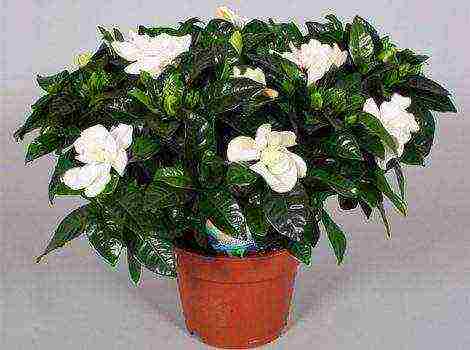Content
- 1 Caring for myrtle at home
- 2 Growing myrtle from seeds
- 3 Propagation of myrtle by cuttings
- 4 Diseases and pests of myrtle
- 5 Types and varieties of myrtle
- 6 How to make myrtle leaf tincture?
- 7 Legends, beliefs about myrtle, its medicinal and other useful properties
- 8 What to do after purchasing myrtle?
- 9 Caring for myrtle at home
- 10 Reproduction of myrtle
- 11 Diseases and pests
- 12 Growing difficulties
- 13 The healing properties of myrtle
- 14 Rules for growing and caring for myrtle (video)
- 15 Description of the plant
- 16 The subtleties of growing
- 17 Reproduction methods
- 18 Diseases, problems and pests
Myrtle is a plant for those who love peace, comfort and tranquility. Myrtle is an evergreen shrub or tree that belongs to the Myrtle family, which has about a hundred species. Native to the Mediterranean, myrtle grows naturally in tropical and subtropical climatic zones. In the Crimea, in the Caucasus, on the Black Sea coast, myrtle is grown in the open field as an ornamental plant. In a greenhouse, it grows up to 2 meters, but when grown in a pot, it is modest in size. The leaves of the myrtle are small, glossy, ovoid, arranged oppositely.
The trunk is ligneous, branches well. Myrtle blooms are small, solitary, white fragrant flowers. They appear in the axils of the leaves, towering on a long peduncle. Blooms from early summer. Pollinate indoor myrtle with a brush. In autumn, pollinated plants bear fruit - juicy, spicy berries of dark blue color appear. The seeds from the fruit can be used for propagation.
Having provided proper care for the plant, myrtle will delight with its decorative effect throughout the year. Unpretentious, can settle with you for a long time. It lends itself well to pruning, which allows you to form a beautiful crown in the form of a pyramid, a ball and other shapes.
Caring for myrtle at home
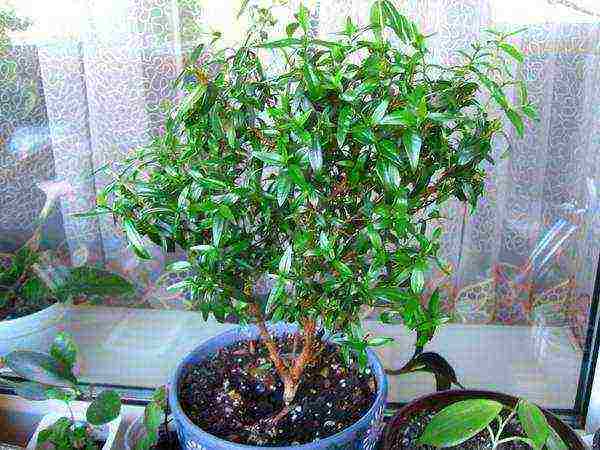
How to care for myrtle at home photo
Watering
Home myrtle is unpretentious in care. It will take up little space, growing will not be difficult. Provide timely watering and spraying. The plant loves moisture very much. During the period of active growth - in spring and summer - the soil should be constantly moist. During this period, it is also advisable to spray the myrtle foliage daily. Sometimes a warm shower can be arranged. Use softened, settled water for irrigation and spraying. Reduce watering as temperatures drop. In no case do not allow the earthen coma to dry out, if this happens, then the myrtle begins to dry and fall off.
Excessive watering is another destructive extreme, fraught with root rot. Avoid stagnant water in the pan and pot.
Lighting
Myrtle loves bright lighting with some direct sunlight, but shade a little at midday. If the myrtle tree is constantly kept in the shade, even if all other rules of care are provided, it will not bloom. Myrtle is not afraid of drafts. On the contrary, air currents will better carry favorable phytoncides.
Temperature
The plant will thrive in cool environments. Moderate or slightly lower than moderate air temperature (within 18-23 ° C) is suitable. Maintain a cool air temperature of 6-8 ° C in winter to obtain abundant flowering. In the absence of such an opportunity, it is possible to winter in a warmer room, but with more frequent watering and spraying.
Why does myrtle shed leaves?
In winter, during the operation of heating systems, the air becomes warm and overdried - this can cause the leaves to fall off the myrtle. Do not despair, continue to water the plant moderately and by the spring it will be green again. The myrtle, which has undergone a warm winter, most likely will not bloom. In summer, myrtle can be taken out into the open air.
Top dressing
For successful growth and good development, indoor myrtle needs to be fed. Apply organic mineral fertilizers every two weeks. During wintering, additional feeding is not needed.
How to trim and shape a myrtle crown
Under indoor conditions, common myrtle is usually grown. It tolerates pruning very well. Even if the myrtle does not bloom, the formation of the crown will allow you to grow a beautiful bonsai-type tree. Do not expose the trunk too much, because it is not very durable. Leave as many side shoots as possible. However, if you want the tree to bloom, you should not get carried away with pruning either, otherwise flower buds will not form.
Cropping myrtle on video:
Transfer
Home myrtle can grow for a very long time, it does not need to be updated every few years, like many other plants, but it is still necessary to replant. This is done before the start of active growth - in early spring. Young plants will need an additive every year, adults as needed (every 2-3 years). A suitable substrate is a mixture: turf soil + humus soil + peat + sand, mix in proportions 2: 1: 1: 1. Be sure to lay drainage at the bottom of the pot.
Growing myrtle from seeds
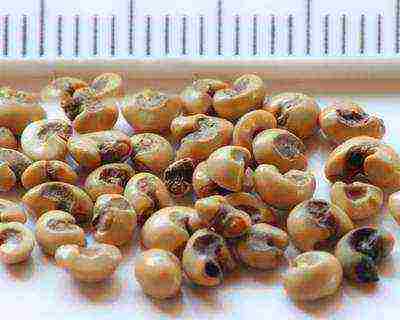
Myrtle seeds photo
Reproduction by seeds and cuttings is possible. During seed propagation, varietal characteristics may be lost if the seeds are taken from hybrid bushes. Only fresh seeds germinate well. Wash the seeds without pericarp in a weak solution of potassium permanganate, dry.
Plant in bowls using light soil. The seeding depth is 0.5 cm. Cover with foil or glass to create a greenhouse effect. Place in a warm, lit place, out of direct sunlight.
Ventilate the seedlings regularly, moisten the soil, but do not flood. Expect seedlings in 1.5-2 months, with their appearance the film must be removed. When the seedlings grow up, they are dived into separate pots. When you reach a height of 15-20 cm, you need to pinch young shoots, stimulating the growth of new ones. Myrtle grown from seeds will bloom by the 5th year of life.
Propagation of myrtle by cuttings
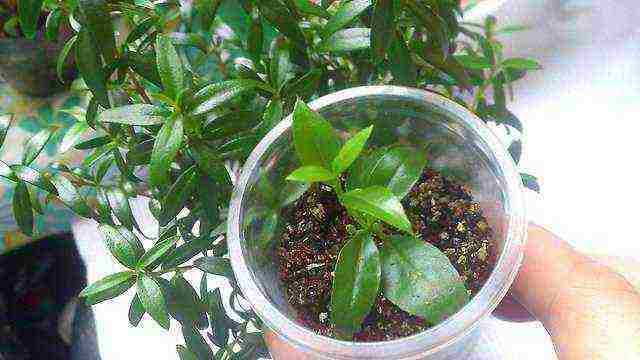
Cutting myrtle photo
It is easier to grow myrtle from stem cuttings. They take root very well.
- Cut off the cuttings in early summer from the upper, non-flowering shoots.
- The cutting should have 3-4 pairs of leaves.
- Approximately 1 cm of the bottom of the cutting should be immersed in a phytohormone solution and kept for about 2 hours, then rinsed with clean water.
- Plant the stalk in a wet sand-peat mixture, deepen it by three knots at an angle of 45-50 °.
- Cover the top with plastic wrap or a cut clear plastic bottle and place in a warm, shady place.
- Air the seedlings. New shoots will appear in about a month.
- Then the shelter must be removed and placed in a bright place.
In the future, take care of it like an adult plant. Such myrtle should bloom in 2-3 years.
Video about grafting myrtle:
Diseases and pests of myrtle
Myrtle diseases occur due to improper watering. It is important to constantly keep the ground moist, but avoid stagnant water in the flowerpot and pallet itself.Excessive watering can provoke the onset of root decay, which will spread further and the plant will simply die. Due to dry air and insufficient watering, foliage may turn yellow and fall off, but moderate watering will resume the plant. Also during this period spider mites can attack. You will recognize their appearance by the presence of cobwebs. Leaves, especially on the underside, need to be washed with water or a weak tobacco solution, sprayed with ground sulfur, or apply insecticides (spray outdoors).
When scale insects appear on the plant, it can secrete resin, and the leaves and stems become covered with dark spots. The plant can be treated with a soap-tobacco solution. If the scabbards are already clearly visible, soak the swab in vodka or denatured alcohol and remove the pests mechanically. Then treat with an insecticide or, more gently, with soapy water, to completely destroy the larvae.
If the leaves dry up and curl up, most likely, aphids have appeared - small insects of green, black or gray color, located on the lower part of the leaf. They multiply very quickly. Treat immediately with special preparations available from flower shops.
Types and varieties of myrtle
Common myrtle Myrtus communis
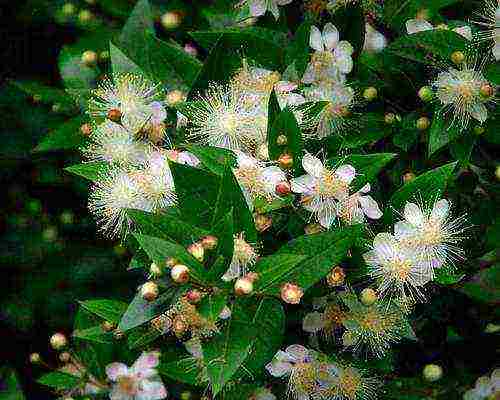
Common myrtle Myrtus communis photo
The Russian interpretation of the Latin name — Myrt Communis — is an evergreen tree that reaches a height of 50 cm to a meter in indoor conditions. Leaves are small, glossy, leathery, oblong, opposite.
Variegated Myrtle Myrtus Variegata
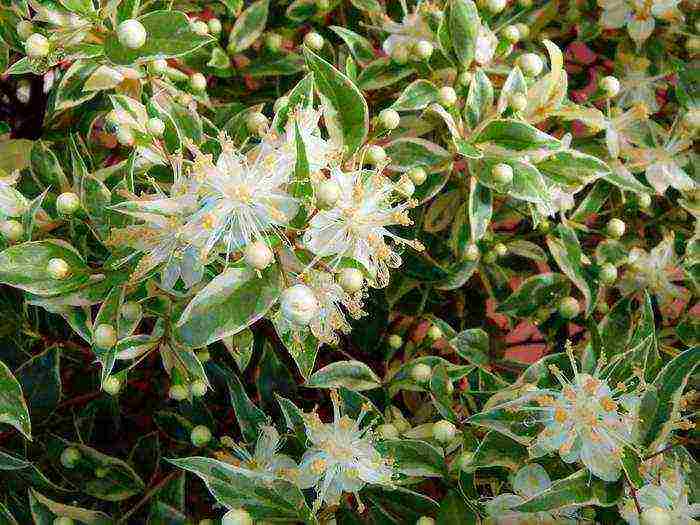
Common myrtle variegated photo
The foliage is variegated, the edges of the leaves are covered with dots and stripes of amber color. The flowers are miniature, beige and snow-white in color with golden stamens, exude a pleasant aroma. Suitable for indoor growing. This species is revered as a symbol of fertility.
The variety Myrta Hymenaeus - the name was received in honor of the God of the Marriage Union, people call him the happiness of the bride. Revered as a symbol of youth and beauty. This is an evergreen shrub, reaching a height of 3-5 m in a natural environment, and about 1 meter in a room. Leaves are miniature, lanceolate, emerald in color. The flowers are snow-white with a large number of golden stamens, 1.5-2 cm in diameter. At the end of flowering, blue-black berries are formed with an intense pleasant aroma.
Large-leaved Myrtle Myrtus macrophylla
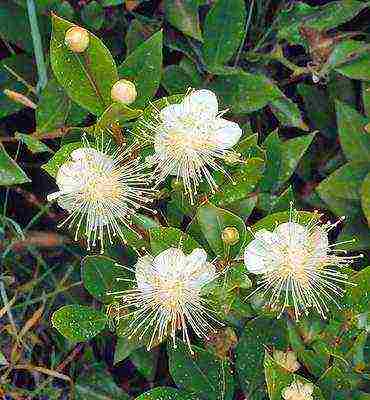
Large-leaved Myrtle Myrtus macrophylla
It has a powerful antibacterial effect, eliminating pathogenic bacteria, bacilli. Helps in the fight against flu, sore throat, sinusitis; in the prevention of treatment of gastrointestinal diseases, prostatitis.
The plant reaches a height of 3-4 m. The tetrahedral stems are covered with large leaves (up to 5 cm in length). Leaves are glossy, with pointed edges, opposite. A five-petal flower of snow-white color with symmetrical golden stamens.
Myrtus Alhambra Myrtus Alhambra
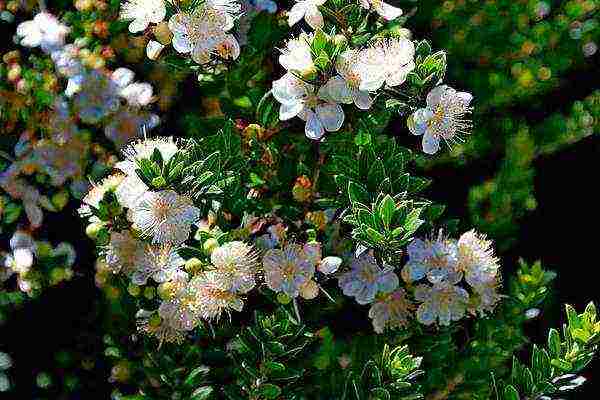
Myrtle Alhambra Myrtus Alhambra photo
An excellent ornamental plant, suitable for growing in the wild and at home. Leaves are compacted, with a high content of essential oils. The flowers are small, white, fragrant. Bloom in late spring. After flowering, white, fragrant fruits are formed.
Myrtle Tarentina Myrtus Tarentina
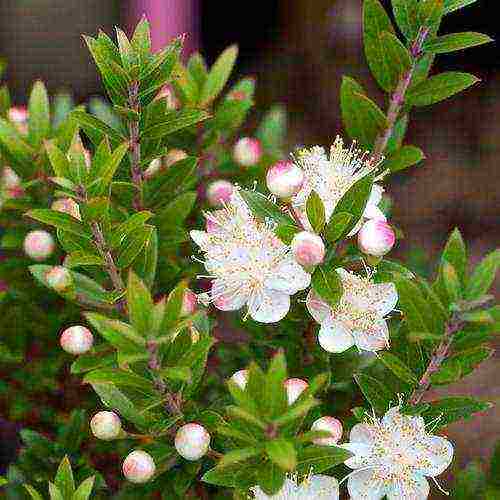
Myrtle Tarentina Myrtus Tarentina photo
A dwarf form of an ordinary subspecies. Small white flowers cover the plant profusely. The leaves are elongated, reaching 1.5 cm, the edges are serrated, pointed, painted in emerald color, attached to shortened petioles. The plant has a fast growth rate. In nature, it grows about 5 m high, in room conditions - up to 1 meter.
Lemon Myrtle Myrtus lemon
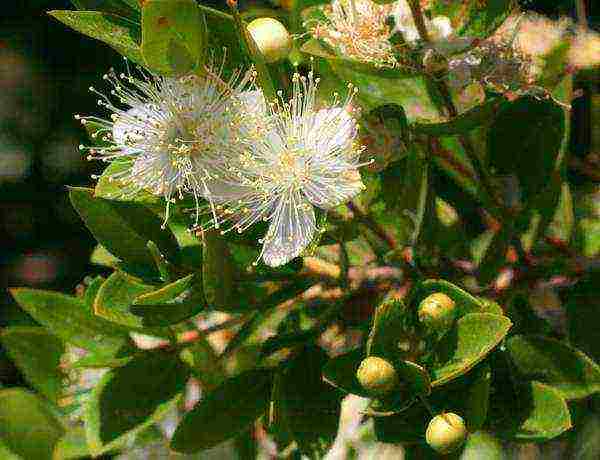
Lemon Myrtle Myrtus lemon photo
Delivers a pleasant lemon scent. Originally from the tropics of Australia. It is widely used in cooking. It is used to make essential oils, various sauces, dressings, syrups and lemon drinks. Dry leaves are used as a seasoning.
Small-leaved myrtle Myrtus communis microphylla
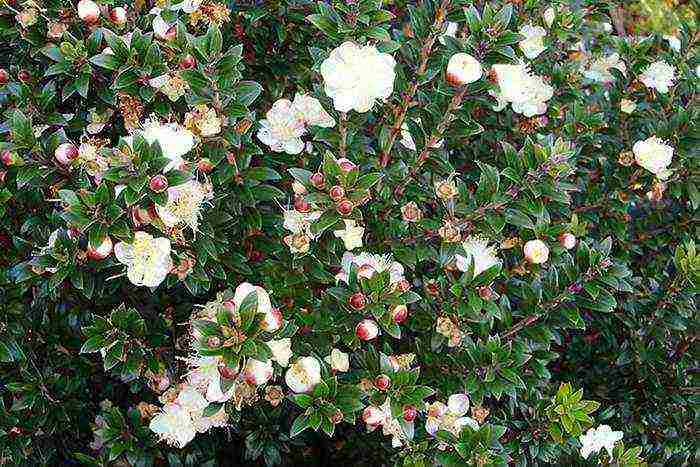
Small-leaved myrtle Myrtus communis microphylla photo
The small-leaved form of common myrtle conquers with its unique elegance with many small, densely planted dense leaves that completely cover the crown of the tree. Along with abundant flowering, it turns the myrtle tree into a festive decoration for any room.
How to make myrtle leaf tincture?
It's pretty easy to do it yourself. Take a liter jar, put about 100 g of leaves there and pour 500 g of 60-70% alcohol or vodka. For two weeks, you need to infuse the mixture in a dark place. It is advisable to shake the jar daily. Then filter the infusion. For the prevention of diseases, 30 minutes before meals, you need to take 20 drops of infusion 3 times a day.
You can get the benefits of the plant simply by placing it in the room: it will purify the air from various viruses and microbes. It is not recommended to put myrtle in the bedroom. You will surely love the aroma exuded by the tree. Myrtle is ideal for both home and office.
Myrtle is a symbol of a strong, prosperous, friendly family. It will be an excellent gift for newlyweds and already experienced families.
Legends, beliefs about myrtle, its medicinal and other useful properties
An ancient legend says that myrtle was brought from Paradise by Adam. The ancient Greeks considered myrtle to be sacred. Myrtle was also revered by the Romans, Egyptians, Jews. Myrtha was credited with the ability to restore youth to the aging skin of the face, and he gave strength and vigor to travelers. For Catholics, myrtle is the personification of the spirit of the Virgin Mary, therefore the peoples of Northern Europe consider it a talisman for a woman. With the birth of their daughter, a myrtle tree was grown, and at her wedding, a veil, a bride's outfit, and a wedding bouquet were decorated with sprigs of myrtle. That is why myrtle is sometimes called an unknown tree.
Myrtle means "balm" in Greek. Its flowers and leathery leaves exude phytoncides - useful substances that can not only protect the plant from diseases, but also purify the air around it, relieve fatigue, and create a positive attitude.
Myrtle essential oil is widely used in medicine and perfumery. Tincture of myrtle is used to wipe the face, which refreshes the skin better than any lotion. Myrtle tincture or a decoction of bark and leaves is used in the treatment of diseases of the throat and respiratory tract, diseases of the genitourinary system and gastrointestinal tract, treat various suppurations and poorly healing wounds.
In ancient times, the fruit of myrtle was insisted in wine, considering it a good tonic, a real elixir of health.
Be careful with folk remedies, be sure to consult your doctor. Treatment with myrtle should be used with caution in elderly people and pregnant women.
Dried fruits and leaves are used as a spice. When baking, smoking, grilling meat or fish, adding a sprig of myrtle will give them a special flavor. Remove the leaves after cooking. By the way, the clove spice is a product of one of the types of myrtle tree.
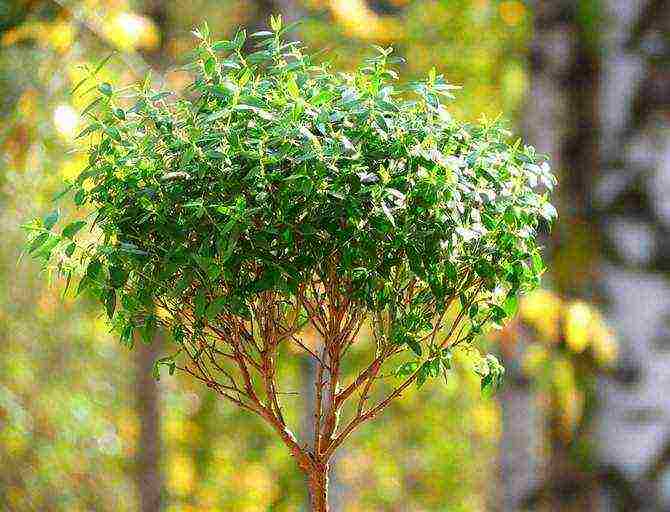
Myrtle (Myrtus) belongs to the genus of evergreen shrubs and trees of the myrtle family. It grows in North Africa, Western Asia, the Caribbean, Florida, the Azores, and Europe. Myrtle translated from Greek means "balm".
Myrtle is an evergreen woody shrub with straight, abundantly branching stems. The leaves are dark green, leathery and dense, attached on short petioles, oblong and pointed to the edge. Myrtle leaves have numerous small glands that can be seen in the light, it is they who secrete aromatic substances and essential oils. Flowers are white or pink, fragrant, arranged singly or in racemes on thin peduncles. The fruits are edible black berries on which the calyx of the flower is attached.
What to do after purchasing myrtle?
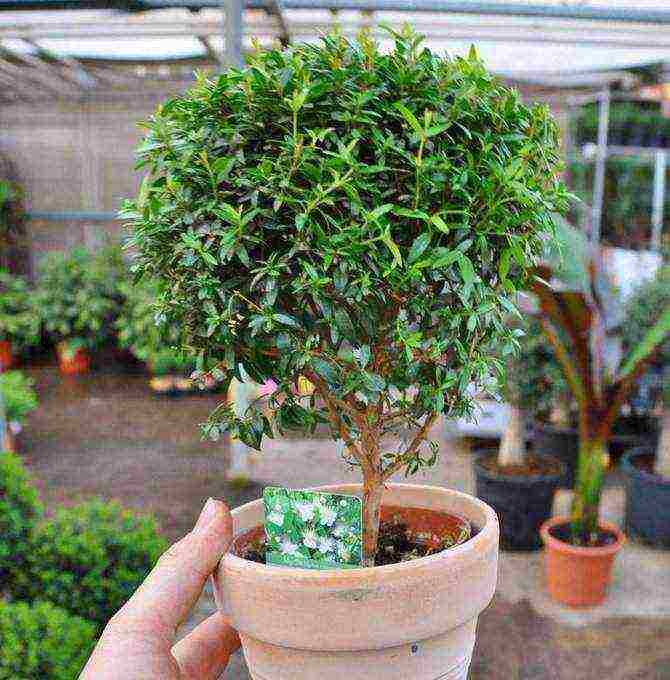
When buying myrtle, you need to understand that the plant has a pronounced dormant period.This means that you need to care for myrtle in summer and winter differently. Because of this feature, myrtle can be found in different places depending on the temperature in the house and the time of year. The most favorable time for a plant is summer. Myrtle is very fond of fresh air, so the plant can even be dug into the ground along with the pot, for example, in the garden. Before digging in, you need to think and decide on the place where the myrtle will grow.
Myrtle is in great demand among flower lovers. But quite often, when growing myrtle at home, various problems occur. For example, myrtle sheds leaves. This may be due to the incorrect content of the myrtle. Something similar can be observed in the cultivation of such well-known plants as azalea or pomegranate. Caring for myrtle is quite simple, but still has its own nuances.
Caring for myrtle at home

Location and lighting
Myrtle loves bright, diffused light and can easily tolerate direct sunlight. But it is worth considering that the plant should be shaded from direct sunlight during the hot season. If you want to get flowers from a plant, then you need to take into account that the myrtle should be in a well-lit place. In summer, myrtle can be taken out into the open air.
If myrtle grows in a room on a windowsill, then the western and eastern windows will be the best option. If you place myrtle in the south, then it can get sunburn. In the north, the most unfavorable place for flowering: the flowers will be faded and will quickly disappear. It can also be noted that the light acts on the myrtle as a signal to awakening.
In winter, you need to give the plant as much light as possible. If the myrtle stands in the south, then the dormant period will last only a month, if in the north, then all three. If you had to change a permanent place, then this should be done gradually. Indeed, in a different place, the level of light will be different. Myrtle can lose light or, on the contrary, receive its surplus, so you need to approach the rearrangement of the tree carefully and gradually. The plant does not like a sharp change of residence. It is worth starting with the fact that little by little the myrtle can be placed a little further from the window, so it will quickly get used to the new conditions of detention.
Temperature
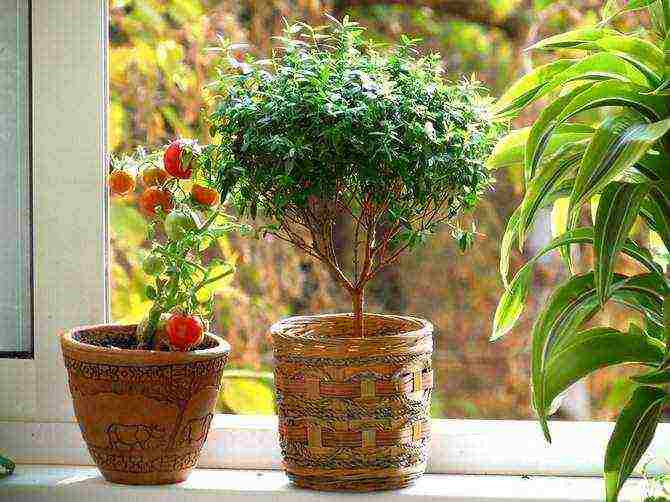
In summer, room temperature is quite suitable for myrtle. In general, the plant likes cool or moderate temperatures. The most favorable air temperature is 18-20 degrees. In winter, it is better to move the myrtle tree to a cool room with an air temperature of 6-8 degrees Celsius. Under these conditions, the myrtle will bloom profusely in the summer. You can, of course, arrange the wintering of myrtle at room temperature, but in this case, you will need abundant watering and constant spraying.
With warm and dry air in winter, myrtle leaves often fall off, although you should not despair. If you continue to water the tree moderately, it will turn green again in the spring, but the myrtle, which has endured a warm winter, will most likely not bloom.
Air humidity
Myrtle loves humid air, so it needs regular spraying. Usually in winter, when the content is cool, myrtle is not sprayed, but in summer or during the warm season, the plant must be constantly sprayed. This is especially true in autumn and spring, when the plant is just in the active phase of growth.
Watering
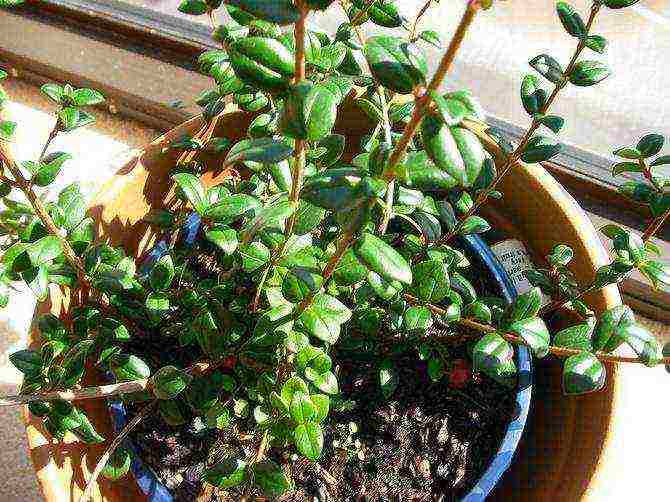
In the spring and summer, the myrtle is watered regularly and abundantly, as soon as the topsoil dries up. In winter, of course, the myrtle needs to be watered less often, but still it is impossible to allow the soil to dry out, otherwise the plant will die. Water the myrtle with warm and, if possible, soft water. It is important to ensure that the soil in the pot never dries out. Regardless of the season - there should always be moist soil in the pot. At the same time, care must be taken that the water does not stagnate in the pot.
The soil
The optimal composition of the soil for growing myrtle: turf, humus, peat soil and sand in equal proportions or clay, turf, peat and humus soil with the addition of sand in a ratio of 1: 1: 1: 0.5.
Top dressing and fertilizers
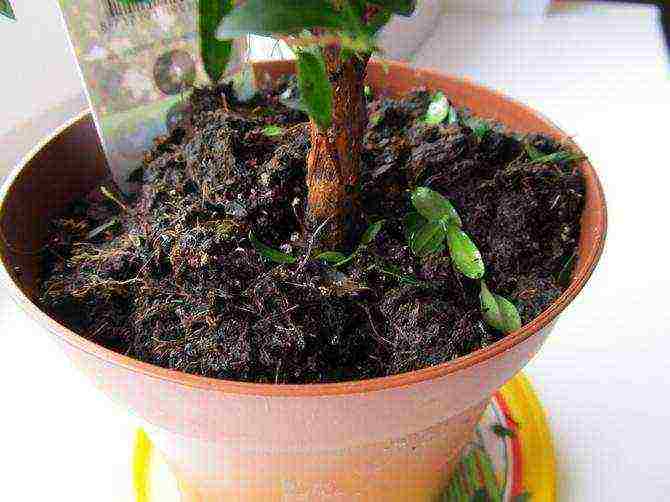
From spring to autumn, myrtle needs to be fed every week. Depending on what kind of tree you want you want to get and the top dressing for the myrtle is selected. If you want the plant to please with its flowering, you need to use a fertilizer with a high level of phosphorus. If you like a miniature tree, then it is better to use nitrogen fertilizers. In general, you can use conventional liquid compound fertilizers for ornamental foliage plants.
Transfer
It is best to transplant an adult myrtle once every 3-4 years, and young plants are transplanted annually in spring before flowering. When transplanting myrtle, it is impossible to deepen the root collar of the plant, this can lead to various diseases or to rot damage. At the bottom of the pot, be sure to lay out a good layer of drainage. The myrtle pot should not be too large, just enough to accommodate the root system. For transplanting and transshipment, you need to pick up a pot that is half the volume of the crown of the plant.
Pruning and pinching

For myrtle, pruning is an opportunity to radically change the shape of the plant and is best done in the spring. If you pinch young twigs in time, you can increase the density of the crown, you can pinch as needed at any time of the year.
You need to pay special attention and spend more time on pruning and pinching myrtle. After buying myrtle, you should decide which tree you want to see at home. For example, if nothing is done, the myrtle tree can eventually take on a pyramidal shape. If you cut off the top of the tree, it will look like a shrub. If you trim the sides, you end up with a lush tree. In any case, how not to cut the myrtle, it will still bloom and delight its owner. But it is important to remember one thing: if the myrtle is often pinched, then the flowers will end up much less than before.
In general, if you look at it this way, the myrtle tree is one of the plants that are fed by their defragmentation. It can always be cut in different ways and thereby give it a unique look. But don't overdo it. When the plant is small, it must be taken into account that the trunk is still young and will not be able to hold a lush bush proudly with a running start. You just need to wait a little and the myrtle will get stronger and after three years it will show itself in the role of a beautiful bush.
One remark when transplanting myrtle, it is necessary to ensure that the trunk remains on the surface of the earth, and so the entire transplant algorithm is suitable, as for other plants living in the rooms of the house. Planting immediately in a large pot is a mistake. For a tree that is only three years old, the pot should be at least 12 centimeters in diameter. The land for the myrtle is bought in the store.
Reproduction of myrtle
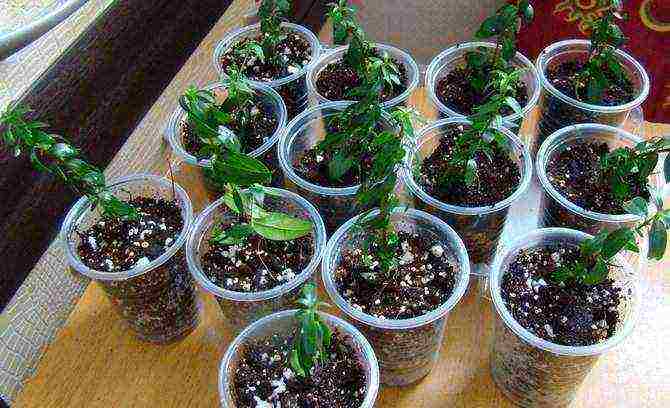
Myrtle propagates by cuttings and seeds. For beginners, it is recommended to propagate the plant by cuttings.
Propagation by cuttings
Reproduction by cuttings should be carried out no more than twice a year. The first time you need to do it in winter (in January-February), and the second time you need to focus on spring or mid-summer (July). Cuttings should be taken from the bottom or middle of the tree. The length of the cutting should be 5-8 centimeters. To prevent moisture evaporation, leaves can be removed from the cutting, the remaining ones can simply be shortened. To make rooting fast, you can use stimulants.
The most suitable mixture for rooting is a mixture of sand and moss. If there is none, then you can use ordinary sheet soil, in which there is coarse sand. The temperature at which the rooting procedure will take place should be in the range of 16-20 degrees.
The best time to root is winter.Light at this time is completely unnecessary for the handle - on the contrary, you need to shade this place. Rooting utensils should be strictly not deep, after rooting, you need to cover the shank with a cap. Sometimes the plant needs to be ventilated so that it does not fester at its early age. It usually takes about a month for rooting. After that, it can be safely planted in a small pot about 7 centimeters in diameter.
When propagated by cuttings, flowering occurs at 3 or 4 years.
Seed propagation
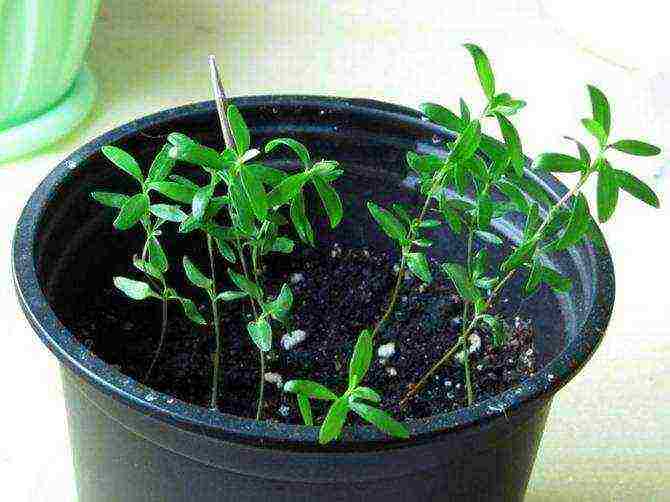
Seeds are evenly distributed over the soil surface and sprinkled on top with a thin layer of substrate. The container with seeds is covered with foil or glass to create greenhouse conditions. The temperature must be maintained within 18-20 degrees. The container with seeds must be ventilated periodically. The soil is kept moist all the time.
Seedlings usually germinate in 1 to 2 weeks. When the seedlings have two full leaves, they can be transplanted into separate small pots. The transfer is carried out by the transshipment method. In the future, care for young plants is the same as for adult myrtle. Transplant when the roots completely fill the pot.
When myrtle is propagated by seeds, flowering occurs after about 5 years.
Diseases and pests

Myrtle can be affected by aphids and scabbards, and with dry air and insufficient moisture by a spider mite.
The scale insect is practically invisible at an early stage, but it multiplies rapidly, covering the stems and leaves of the plant with dark spots. The scabbard is removed with a damp swab, but it is still necessary to treat the entire plant with insecticide or soapy water.
Aphids often settle on the underside of the leaf and feed on the sap of the plant, which causes the leaves to dry out and curl up. Aphids are destroyed by insecticidal agents.
The spider mite appears on the underside of the leaves and envelops them with thin white cobwebs. It is destroyed by spraying and washing the leaves, especially from the underside, with water or a weak tobacco infusion. Myrtle can also be treated with ready-made universal insecticides.
Growing difficulties
- The stems are stretched, the leaves become shallow and pale - a lack of lighting.
- The leaves fade, turn yellow, the edges curl - excess lighting.
- Leaves fall - insufficient lighting in winter or warm wintering.
The healing properties of myrtle

In conclusion, we can say that myrtle is an amazing plant. Apart from the fact that the myrtle blooms, and the flowers smell beautifully, it also has medicinal properties. Even the smallest tree can protect against diseases and viruses in the home. As you know, myrtle oil is very popular among the people and has many indications for use.
Myrtle tincture gives energy and vigor to a person, the effect is almost like coffee. Myrtle leaves are boiled and used to treat gastrointestinal diseases. Even in cooking, myrtle has found a use for itself. Very often, the leaves or even the shoots of myrtle themselves are used in the manufacture of fish or poultry dishes. If you throw a twig of myrtle on the coals, then the barbecue will turn out to be simply magnificent: the aroma will simply be incomparable with anything else. Even bay leaves will not be so popular in this area.
For several peoples, myrtle is considered almost a cult tree. Wreaths and bouquets are made from it. A myrtle gift is given to brides, so the plant was named “Bride's Tree”. The myrtle tree is also called the “Tree of family prosperity and happiness”, which personifies a friendly and strong family.
Rules for growing and caring for myrtle (video)
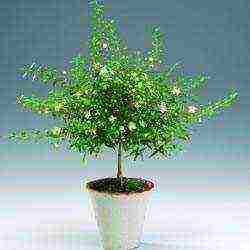 An indoor flower such as common myrtle is not found very often in apartments. But this plant looks harmoniously in any interior. It looks very attractive and unusual, as you can see if you look at its photo.However, fans of home floriculture may have some difficulties in growing myrtle, since it needs to create certain growing conditions and provide proper care.
An indoor flower such as common myrtle is not found very often in apartments. But this plant looks harmoniously in any interior. It looks very attractive and unusual, as you can see if you look at its photo.However, fans of home floriculture may have some difficulties in growing myrtle, since it needs to create certain growing conditions and provide proper care.
Description of the plant
There are different varieties and varieties of this plant, but in indoor floriculture the most famous and popular is common myrtle. At home, it can grow up to 0.6 m, maximum up to 1 m.
Can be grown as a compact tree or ornamental bush. Its leaves are small, leathery, shiny and polished. Single-type inflorescences. In color, the flowers can be white, cream, pinkish. They have a very pleasant and rather strong aroma. During flowering, many stamens are formed. They give tenderness and airiness to the appearance of myrtle. If pollination has occurred, then the fruits appear.
Features of growing myrtle
The homeland of the plant is the subtropics with a humid climate. Similar conditions need to be created for indoor myrtle and at home. It grows well on the southern windows in the apartment, it feels good on the western and eastern windows, and in winter it can be kept on the north side.
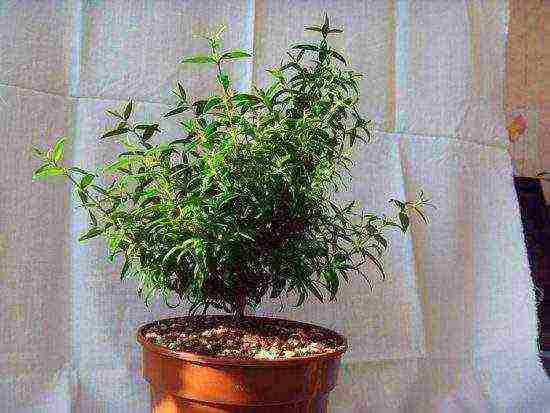
Myrtu needs to create a humid and warm microclimate
Loves warmth and high humidity. In addition to abundant watering, the plant must be sprayed with settled water at least 1 time a day, and more often - up to 2-3 times. To create high humidity, the flower pot itself is placed in a tray with wet gravel poured into it. You can also place containers with water next to it.
Attention! Myrtle also reacts negatively to short-term drying of the soil. From drying out, it sheds its leaves and may even die.
To make this plant feel comfortable, it is provided, in addition to increased air humidity, with the following conditions:
- good lighting - in poor light, the myrtle begins to wither and does not bloom, but it is better to shade it from the direct sun on the southern side in order to avoid darkening and burns of the leaves;
- fresh air - the plant needs ventilation, it is not even afraid of drafts. And in the summer, the flower can be placed on the balcony or planted with a pot in a suburban area;
- a dormant period - in winter, the myrtle should rest, it should be placed in a cool place with a temperature of about 10 degrees. Water and spray it at this time less often, but without completely drying out the soil. In a cool place, the dormant period lasts about 3 months, while in warm places it is shorter and is half this period.
Myrtle care
A plant, like any home flower, needs attention. Caring for myrtle, in general, cannot be called too difficult. It consists of:
- watering;
- spraying foliage;
- dressing;
- forming trim.
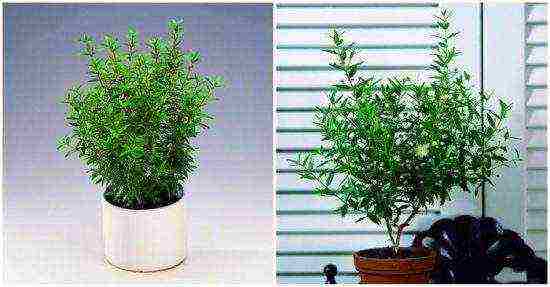
Myrtle tolerates shaping trimming well
Watering during the warm period is done several times a week. It should be abundant, but without flooding the flower. Excess water is immediately removed so that the roots do not rot. In winter, water less often if the flower is kept cool. But when the plant is in a warm room, the watering regime is normal.
Often, home gardeners do not prune their plants, but myrtle needs it. Without this procedure, his crown acquires an unattractive appearance over time. Pruning is best done in early spring or after flowering.
Advice. After pruning in the spring, myrtle may not bloom at all this year. Therefore, for those who expect lush flowering from the plant, it is better to postpone this procedure until the fall.
Myrtle responds well to top dressing. During the warm period, it is fed about 2-4 times a month. In winter, myrtle also needs feeding at least once a month. In the spring and summer, fertilizers intended for flowering plants are more often used, and in the cold period - for decorative deciduous plants.
Flower transplant
Young plants are best replanted annually. It is not recommended to immediately plant myrtle in a large pot with a stock, it is better to increase its size gradually.To prepare the soil, take 30% of sod and peat land, 20% of humus and sand. You can take purchased soil for planting a plant.
Use of drainage is obligatory. And for better survival, the roots of the flower can be treated with a stimulant. After transplanting, water abundantly until water begins to seep out of the pot. It is then removed from the pallet. Adult flowers no longer need an annual transplant. In one substrate, they can grow up to 3-4 years.
Advice. In order not to unnecessarily injure the roots of the myrtle during transplantation, it is better to use the method of transferring the plant along with the old clod of earth into a prepared larger pot.
Plant propagation
Many people prefer to independently breed indoor flowers. To reproduce myrtle, you can use one of two methods:
- seeds;
- by cuttings.

Myrtle cuttings
Cutting is a popular and easy way to get a new plant. It can be carried out in the winter, early spring or in the middle of summer. They take a stalk 6-8 cm in size, but not from a flowering branch, process the cut in a stimulator, then plant it in the ground, covering it with glass or transparent film on top. It will take about 2-3 weeks for rooting, after which the plants can be planted individually.
The seed method is also used, but it takes much longer. Just keep in mind that the germination of myrtle seeds lasts only about a year. In addition, the characteristics of the variety with this method can be lost, and the myrtle will begin to bloom much later than with cuttings.
Common myrtle is a beautiful and fragrant plant that creates a special microclimate in the room. Of course, there are some nuances in its cultivation that can scare away beginners in home floriculture. But caring for myrtle is not as difficult as it seems at first glance, to refuse such an amazing flower.
Growing myrtle: video
The myrtle tree is one of the most attractive and interesting indoor plants. Pleasant aroma, beautiful flowering, ease of formation, high decorativeness - myrtle has these advantages. Home care is organized according to certain rules. You will learn about them from this article.
Description of the plant
The myrtle family is well known among flower growers. There are about 10 varieties of myrtle in total. The homeland of the plant is the Mediterranean. Grows in subtropical climates. In natural conditions, it is a shrub or tree up to 3 meters high. When grown in an apartment, it reaches 60 cm.
The leaves are small, shiny, leathery, oval, dark green. When rubbed in hand, they give off a pleasant spicy aroma. Most of the essential oils are concentrated in small veins. The flowers are small on long stalks, with five petals and many stamens. The color is white or pale pink. Fruits are round small berries of intense blue color.
Interesting information! Myrtle leaves contain phytoncides. They improve and disinfect the air in the apartment. Leaves and dried fruits are used as spices. The most famous myrtle spice is cloves.
The subtleties of growing
Complete home care for myrtle is organized in accordance with a number of rules. Myrtle is considered a capricious plant, often refuses to bloom or sheds leaves. Creating optimal conditions for growth and flowering helps to avoid this.
- Lighting and site selection. Easily tolerates the direct rays of the sun, but loves diffused light more. In the heat, they shade it. It blooms only when there is enough light. The optimal location is the window sills of windows facing west or east. In the summer, the flower is rearranged to fresh air. Provide adequate lighting in winter.
- Temperature. In the summer season, they are kept at 18-20 ° C. In winter, the plant needs coolness. Myrtle is rearranged on a glazed balcony or loggia with a temperature of at least 6-8 ° C.After a good rest, the myrtle blooms luxuriantly and for a long time. When wintering in a room, the flower is well watered and systematically sprayed. This helps to avoid leaf fall, but does not guarantee flowering.
- Humidity. It grows better in high humidity. It reacts to spraying with warm, well-settled water by amicably releasing new shoots. The need for moisture increases during periods of increased growth. At this time, the procedure is carried out daily. Additionally, air humidifiers and trays filled with water are used.
- Watering. Water the plant often - as soon as the topsoil begins to dry out. In winter, the need for water is less, but it is impossible to allow the soil to completely dry out. Stable soil moisture is maintained all year round. Do not allow water to stagnate at the bottom of the pot.
- The soil. The soil for myrtle is chosen nutritious, not heavy, of moderate acidity. A mixture of peat, humus and turf with the addition of sand or perlite is best suited.
- Top dressing. During the period of active growth, fertilizing is frequent - every week. For abundant flowering, fertilizers with a high phosphorus content are chosen. Complex preparations for decorative deciduous crops are regularly used.
- Transfer. Until the age of four, the bushes are transplanted annually. Mature trees - every 3-4 years. The optimal time is spring, before flowering. When transplanting, do not allow deepening of the root collar. A thick drainage layer is provided at the bottom of the planting tank. The size of the pot is determined by the diameter of the crown - it should be half the size. Myrtle will not bloom in a large pot.
- Pruning and shaping. Myrtle is an indoor flower that is very easy to shape. She tolerates a haircut easily, quickly lets out young shoots. Pruning of myrtle is carried out in early spring before active growth begins. The trimming method depends on the desired result. Throughout the summer, the crown of the plant is corrected by pinching too long young shoots.
Important! The lack of flowering may indicate insufficient lighting, a large pot, stuffiness in the room. They correct the situation by daily airing the room, lowering the temperature during the rest period, transplanting into a smaller pot.
Reproduction methods
Reproduction of myrtle is not difficult even for novice florists. Young plants are obtained by cuttings and sowing seeds.
By cuttings
Cuttings are cut twice a year - in the middle of winter or summer. Semi-lignified branches are selected from the middle or lower part of the crown. The optimal length of the cutting is from 5 to 8 cm. Half of the leaves are removed from the cutting, the remaining half are cut off. The lower cut is dipped in a growth stimulator. A mixture of heteroauxin with 0.25% ascorbic acid content gives a good effect. The container is filled with a light sphagnum and sand substrate. Cuttings are placed in it at a slight angle and covered with foil. A greenhouse with cuttings is placed in a cool, shaded place. During the rooting phase, the temperature is maintained at 16-20 ° C. The greenhouse is periodically ventilated, the level of humidity is monitored, if necessary, the soil is watered and the cuttings are sprayed. They take root quickly - no longer than a month. The seedlings are transplanted into pots with a diameter of 7 cm (a regular plastic cup will do). When the roots are completely entwined with a clod of earth, they are transferred into a larger pot. The first flowering is not earlier than 3 years later.
Seeds
Seed myrtle grows more slowly. When using seed harvested from the mother plant, the characteristics of the variety may differ. The germination substrate is a mixture of peat and vermiculite. Before sowing, it is watered with a weak fungicide solution. Myrtle seeds are scattered over the surface, covered with a very thin layer of substrate on top. The landing container is covered with glass. Maintain the temperature at the level of 18-20 ° C, monitor the soil moisture - it can neither be overdried nor overmoistened.Every day, the glass is briefly removed, airing the greenhouse. When favorable conditions are created, seedlings appear in 1-2 weeks. Dive into separate pots in the phase of 2 true leaves. Flowering - not earlier than 5 years of age.
Important! Young seedlings grow very slowly. To accelerate growth, they provide high-quality care and regular feeding.
Diseases, problems and pests
Young myrtle rarely gets sick. Mature and old bushes are less resistant to pests and negative factors.
- Aphids and scale insects. They attack the plant with insufficient moisture. Correct the conditions and carry out the treatment with anticoccidal agents.
- Spider mite. Appears when there is insufficient soil moisture. Myrtle is treated with insecticides.
- Fungi and putrefactive bacteria. Their appearance provokes constant waterlogging of the soil. The plant is transplanted by removing the affected parts.
- Yellow, dull leaves with curled edges. Sign of excessive lighting.
- Shredding leaves, pulling stems. The reason is poor lighting.
- Falling leaves. Increased temperature and dry air in winter or stagnant water in the root system.
Growing myrtle at home is challenging but exciting. Having mastered shaping, you can give your myrtle any shape.

